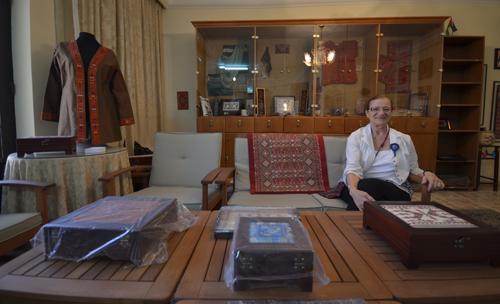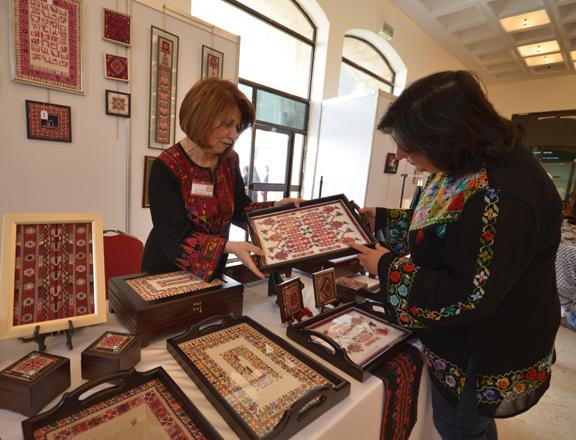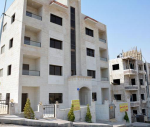You are here
Stitching a living: embroidery provides income for Palestinian refugee women
By Mina Mohit - Oct 17,2017 - Last updated at Oct 17,2017

Siham Abu Ghazaleh, assistant president of the Palestinian Culture Centre, and Summaya Abu Ali Sattari discuss embroidery designs (Photo by Mina Mohit)
AMMAN — Summaya Abu Ali Sattari is a 35-year-old woman living in Baqaa, the largest Palestinian refugee camp in Jordan. Her usual day begins with waking up, making breakfast for her husband and preparing her two children for school. After everyone leaves, she spends her day doing embroidery.
She sits on the floor, sometimes with her neighbours, and starts creating colourful patterns through hundreds of stitches on different fabrics.
While embroidery is often perceived as a creative hobby, Sattari does it as a job. “Whoever needs the money must work 10 hours a day,” she told The Jordan Times at her residence while discussing the expensive living conditions in the country.
“My husband works as a guard at a farm, and we have two children, so one income isn’t sufficient to support the whole family,” she stated.
Sattari first found out about this work opportunity 15 years ago, when a group of women told her about an NGO paying women to make traditional Palestinian dresses. That’s how she met Siham Abu Ghazaleh, assistant president of the Palestinian Culture Centre.
The centre employs Palestinian refugee women who work at home, and arranges regular meetings to supply them with new threads and templates to create dresses that are in line with today’s fashion, Abu Ghazaleh said.
Every Monday, women from camps across the Kingdom take “up to three different modes of transport” to get to the centre in Amman’s Rabia neighbourhood, where they meet with facilitators and get remunerated for their finished pieces and their transport costs, said Samira Darras, a 25-year-volunteer at the organisation.
The separate embroidered pieces are washed, sewed together by the centre’s tailors, priced by the administration and sent for shipping to various exhibitions in Jordan and Kuwait.
The handmade dresses, depending on the intricacy of the design “can take up to two years to make”, and are sold “anywhere between JD150 and JD900”, said Darras, noting that the proceeds first go to refugee women, with the remaining funds going towards university scholarships and hospitals in Palestine.
For Darras, employing these women does not only help them financially but it also teaches the younger generation about this long-lasting Palestinian tradition.
This is the case of Sattari’s 15-year-old daughter, Bushra, who has taken interest in the Palestinian art of embroidery and often helps her mother in completing designs.
Sattari said she is happy to be able to contribute to her household income but cannot ignore the health implications of the job. “[The work] affects your eyes, your neck, and it causes disc and back pain. Sometimes, my husband complains and discourages me from doing embroidery [because of my health], but I’m doing it anyway.”
Ultimately, Sattari said she gets to choose her own work load and the type of clothing she makes.
“Siham [the supervisor] never forces us to fulfil a specific quota, we take what we like, and the organisation gives us the option of making more than one thing. Apart from dresses, I can make kuffiyehs and trays,” she explained.
When she heard that her work was sold at the Abdoun exhibition two weeks ago, she said: “I was very proud that I can use my hands to make beautiful things that appeal to people.”
Sattari is one of more than 500 women employed by the Palestinian Culture Centre, using traditional cross-stitch embroidery to make an income for themselves and their families.
Related Articles
AMMAN — The Palestinian Culture Centre on Tuesday opened its eighth annual Cultural Exhibition featuring a number of culturally significant
AMMAN – After Israelis forced Palestinian families to leave their homes in 1948, many Palestinian women in the refugee camps resorted to sel
AMMAN — Sundos Halawa has been working hard to learn the Palestinian dabka and perform it while wearing the traditional dress to show her Pa


















